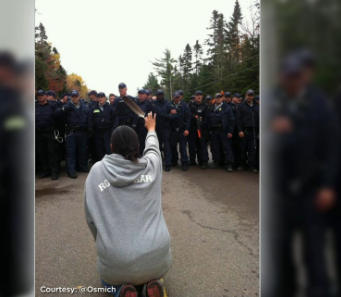There is a picture circulating widely over the Internet of a woman on the front lines of the struggle against SWN Resources, a company which seeks to potentially frack on traditional Mi’kmaq and Elsipogtog Nations territory in New Brunswick.
In the photo, she is kneeling in front of a line of armed Royal Canadian Mounted Police (RCMP) officers, holding an eagle feather.
Eagles are one of the most — if not the most — important bird for Indigenous people. It can fly the highest so it is closest to Creator. That is where the eagle and its feathers get their reverence.
So no, she didn’t have a gun or a sword.
Perhaps arming yourself with a feather in the face of extreme police repression — the RCMP had an attachment of snipers in camouflage when they raided the blockade Thursday morning — seems useless.
But with that eagle feather, she was protecting her people.
The same goes when First Nations activists and their allies carry drums, sing traditional songs and burn traditional medicines like sage and sweetgrass during demonstrations.
To understand the context behind Indigenous uprisings such as the recent uprising in Elsipogtog — which means “River of Fire” in Mi’kmaq — and why they came to head after SWN Resources issued the blockades an injunction on Wednesday October 2, 2013, one needs to understand the importance of right spirit and good living.
To walk the Red Road is to defend Mother Earth. This is what anti-fracking activists are doing in New Briunswick with their highway blockade.
The blockade was on Highway 134 and has since been taken down by the police.
As demonstrators were being arrested yesterday at the blockade site near Rexton, New Brunswick — more than 40 arrests were made, including Chief Aaron Sock — you could hear the powerful drums and people singing the Mi’kmaq Honour song.
As the police shoved and beat demonstrators, dragging them into the ditch to be arrested, the song and drums were doing the heavy work of supporting the demonstrators.
Perhaps it seems odd to hear people singing such a beautiful song as the Mi’kmaq Honour Song during such violence.
Again, mainstream activists and supporters, as well as the general public, need to understand the context that is Indigenous resistance.
Sacred items such as eagle feathers, drums, smudge, shakers and songs are all powerful spirits to support Indigenous hearts.
They are as powerful as any modern weapon like an axe or gun. When treated with proper respect, they keep Nations strong.
Demonstrators across the country have sung the Mi’kmaq Honour Song to provide the blockaders with strength.
“Kepmite’tmnej ta’n teli l’nuwulti’kw
Nikma’jtut mawita’nej
Kepmite’tmnej ta’n wettapeksulti’k
Nikma’jtut apoqnmatultinej
Apoqnmatultinej ta’n Kisu’lkw teli ika’luksi’kw
Wla wskitqamu eya eya
Wey u we he haiya, Weu we he haiya
Wey u we he haiya, Weu we he haiya
Wey u we he haiya,
Wey u we he haiya, Weu we he haiya
Ta Ho!”
Translation:
“Let us greatly respect our nativeness
My people let us gather
Let us greatly respect our aboriginal roots
My people let us help one and other
Let us help one and other according to the Creator’s
intention for putting us on this planet.”
The anti-fracking standoff in New Brunswick has been going on since June and the companies involved are SWN Resources and Irving Oil.
Most recently, demonstrators had been holding critical fracking seismic trucks hostage, but it was the recent injunction a week ago that prompted the RCMP to move in.
On October 1, 2013, Chief Aaron Sock issued an eviction notice to SWN Resources.
The police moved in yesterday morning.
And now suddenly mainstream Canadians can add a new word to their vocabulary alongside the word Attawapiskat. It’s sad that it takes a crisis to get mainstream Canadians and politicians to notice.
Paul Richard, a member of the Mi’kmaq nation, stated, “There is a lot of anger and old trouble in the region, between the Acadians and the Anglophones and between Canadians and New Brunswick Indigenous communities. But now it’s good to see everyone working together.”
During the day on Thursday, at least five police vehicles were burned. At the blockade site, the RCMP deployed dogs, rubber bullets, pepper spray and RCMP snipers.
The RCMP retreated at 7:00 p.m. that night.
When, at the end of the day, people can rally: “Yay, no one died on the front lines today,” shows the absolutely sad state of affairs between First Nations communities and the police and government.
Rick Rogers, an Anishinaabe Ogichidaa, commented to me today at a sweat, “The Canadian nation has existed alongside different Indigenous nations, but this militant action by the RCMP is an act of war.”
Krystalline Kraus is an intrepid explorer and reporter from Toronto Canada. A veteran activist and journalist for rabble.ca, she needs no aviator goggles, gas mask or red cape but proceeds fearlessly into the democratic fray.



